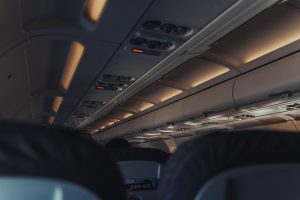
Ever wonder how oxygen masks work on airplanes? Before takeoff, flight attendants will typically show passengers where the oxygen masks are located and demonstrate how to use them. Because they are designed strictly for emergencies, however, most passengers never actually use them.
Why Airplanes Have Oxygen Masks
Airplanes have oxygen masks so that passengers, as well as flight crew members, can breathe if the cabin loses pressure. Most commercial airliners fly at about 30,000 to 42,000 feet above sea level. At high altitudes such as this, the air is too thin to safely breathe. The oxygen molecules are spread too far apart, and breathing the air at high altitudes can cause serious health problems like hypoxia.
Airplanes have pressurized cabins with an oxygen concentration of about 20.9% — the same oxygen level as sea level. If the cabin loses pressure, though, the oxygen concentration will quickly drop, which is why airplanes have oxygen masks. They can provide passengers and crew members with breathable oxygen until the airplane has descended to an altitude with thicker air and higher oxygen levels.
Automatic and Manual Deployment
Most oxygen masks can deploy automatically or manually. Automatic deployment occurs when the cabin has lost pressure and the airplane reaches or exceeds a certain altitude — typically about 14,000 feet. Airplanes have sensors that monitor the cabin pressure. If a sudden loss of pressure is detected, the oxygen masks will be deployed once the airplane reaches this altitude.
In addition to automatic deployment, oxygen masks can typically be deployed manually. Flight crew members can manually release them from the cockpit.
How Oxygen Masks Work
Whether they are deployed automatically or manually, the oxygen masks will typically drop from overhead compartments above the airplane’s seats. Contrary to popular belief, however, they aren’t connected to oxygen tanks. Instead, oxygen masks leverage a chemical reaction to generate and supply passengers with oxygen.
Once deployed, passengers will need to pull down the oxygen masks. This pulling action triggers the chemical ignition process. A spring-loaded striker will ignite a percussive device, which causes a chemical reaction that converts sodium chlorate into sodium chloride and oxygen. Oxygen will flow through the masks and to the passengers.
The oxygen provided by this chemical reaction doesn’t last forever. Normally, it lasts for about 12 to 20 minutes. The good news is that it’s typically enough time for pilots to safely descend to a lower altitude, at which point the oxygen masks will no longer be needed.



